Arch in the Sky (2002).
It’s that pose again. More paintings and drawings here.
Elsewhere on { feuilleton }
• The gay artists archive
• The recurrent pose archive
A journal by artist and designer John Coulthart.
Painting
Arch in the Sky (2002).
It’s that pose again. More paintings and drawings here.
Elsewhere on { feuilleton }
• The gay artists archive
• The recurrent pose archive
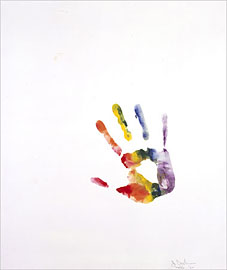
Left: Handprint (1964).
Bull’s-Eyes and Body Parts:
It’s Theater, From Jasper Johns
By HOLLAND COTTER
New York Times, February 2, 2007
WASHINGTON — Art and crass are all but inseparable. So it’s no surprise to find an exhibition that brings together a record number of Jasper Johns’s famous target paintings being bankrolled by Target. You pass the corporate bull’s-eye logo, small but vivid, on a wall on your way into “Jasper Johns: An Allegory of Painting, 1955-1965” here at the National Gallery of Art.
Mr. Johns’s targets, endlessly reproduced in the half century since he painted the earliest of them, have themselves become a form of advertising, a logo for American postwar art. Through sheer omnipresence they’ve become nearly invisible. What could change that now?
The answer: Seeing them live. The 15 “Target” paintings installed in the show’s first gallery look every bit as radical and mysterious as they surely did in New York in the 1950s, when, simply by existing, they closed the door on one kind of art, Abstract Expressionism, and opened a door on many, many others.
The National Gallery show, organized by the museum’s curator of modern and contemporary art, Jeffrey Weiss, has mysteries of its own. It isn’t a survey of the decade 1955-65, but a selection of 90 Johns works from that time organized by visual theme: targets, “devices,” words and the human body. Other motifs at least as important to that phase of his career, like flags, numbers and maps, are nowhere in evidence. Nor can the connective “allegory” proposed by the exhibition title be readily discerned. No matter.
Walk in the door, and you’re hooked. Try to move through the show in a hurry, and you can’t. The work is too strong, too unusual. It keeps stopping you, here, then here, then here. Mr. Johns, you suddenly remember, doesn’t just create visual objects, he creates situations, events. Each painting is a mini-theater, with farce and tragedy silently acted out and the audience invited to participate.
Initially Mr. Johns wanted the participation to be physical. “Target With Plaster Casts” (1955) is a painting surmounted by a row of wooden niches holding casts of body parts: a hand, a foot, a penis, a breast. And each niche has a little flip-up door, designed to be opened and closed by viewers, to give them a different, more intimate art experience than usual. Of course, if you reach for them now, in a museum, you risk arrest. So the real message, which Mr. Johns must have anticipated, is: Touch, but don’t touch.
His art is built on such ambiguities. Most of his very early paintings, done in a thick encaustic medium that makes them look molded instead of brushed, feel like sculptures. Many of those done a bit later in oils have three-dimensional objects attached to their surfaces so that, like furniture, they carve out sculptural space.
Dada, cerebral and vacant, was a big influence on Mr. Johns. His group of paintings made up of the stenciled names of colors — red, yellow, blue — was inspired in part by Marcel Duchamp’s use of language as art. Duchampian too are the so-called “devices” paintings, which have rotatable wooden discs, with squeegeelike arms for smoothing arcs of paint, affixed to their surfaces.
One assumes that Mr. Johns was declaring his complete dissociation from gestural abstraction, with its fetishized brushstroke, its existentialist soul, its emotional acting out. But then you arrive at a word-painting like “False Start” (1959), which explodes with hysterical brushwork. Or “Device Circle” (1959), on which the attached wheel looks gloomily derelict, like a one-handed clock. Or “Painting Bitten by a Man” (1961), which has a mouthful of wax encaustic gnawed out of its center, leaving a mark like a frozen scream or guffaw.
What’s the story? Is he mocking expressive painting or declaring it compatible with Dada’s cerebral conceits? Is he exposing a reserve of hidden passion beneath Duchamp’s dandyish, bone-dry wit?
In 1962 Mr. Johns made a group of prints by pressing his face and hands, covered with baby oil, onto large sheets of paper. The resulting images suggest a person swimming up from beneath an opaque surface that he is unable to push through. Over the next two years he finished two paintings and a drawing that referred to Hart Crane, the American poet who jumped off a ship in midsea and drowned.
The larger of the paintings, “Diver,” is very large and holds a compendium of motifs from earlier work: stenciled words, turbulent brushwork and a rainbow-colored target. At the center, two long wooden arms, ending in palms-open hands, reach upward.
If the painting theatrically approximates the psychic splintering that drove Crane to suicide, the related charcoal drawing, also called “Diver,” suggests the aftermath of his leap. Here the arms have hands at both ends. They point both downward and upward, with the descending hands meeting to form the shape of a skull in a subaqueous twilight.
It is in these theme-gathering works that a narrative, or “allegory,” comes together, though how to interpret it is hard to say. Countless glosses have been applied to Mr. Johns’s art, which is always assumed to be thick with coded meanings. Critics and scholars have scrutinized the art he has looked at, the writers he has read, the thinkers he has thought about.
Others have parsed his life. The artist Robert Morris, in a powerful catalog essay, links the themes of targets, flags and maps to Mr. Johns’s stint in the Army from 1951 to 1953. The art historians Kenneth E. Silver and Jonathan Katz have noted the dark, personal turn in his art after he and his lover, Robert Rauschenberg, split up in 1961. Their relationship seems to have shaped the careers of both men. It lives on in an art-world game that pits them against each other in a who’s-greater competition, though they are very different kinds of artists.
And what kind of artist is Mr. Johns? Various labels have been advanced: post-Dada, proto-Pop. I would call him a metaphysical artist, in the way that the 17th-century English poet John Donne is a metaphysical poet. Like Donne’s poetry, Mr. Johns’s art is equally about body and mind, sensuality and reflection. It is unmystical, unromantic, unnostalgic but obsessed with transcendence and the reality of loss.
Despite the difference in medium, the languages of Donne and Mr. Johns share many features: deliberate awkwardness, ungraceful beauty, a virtuosity so extreme that it turns weird. Their work can be startlingly, even embarrassingly candid, but is more often self-protectively opaque. Metaphor, rather than statement or confession, is their method. Some people find Donne manipulatively difficult and withholding. They might feel the same about Mr. Johns.
Finally, both metaphysicians appeared when a culture was on the cusp of change. And they were prepared to engage with that change, boldly, anxiously, in long careers that were electrifying early but are of profound interest all the way through. Mr. Johns’s career is of course still very much in progress, and I look forward to each future phase. I know of no major postwar American male artist whose work more completely approaches the condition of poetry, that reads as richly as it looks. To me it always feels new.
“Jasper Johns: An Allegory of Painting, 1955-1965” continues through April 29 at the National Gallery of Art, East Building, Constitution Avenue between Third and Ninth Streets, Washington; (202) 737-4215, nga.gov.
Previously on { feuilleton }
• Michael Petry’s flag
• Dada at MOMA
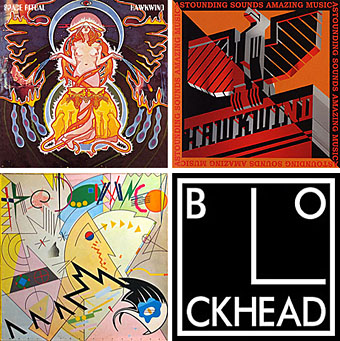
Image-heavy post! Please be patient.
Four designs for three bands, all by the same designer, the versatile and brilliant Barney Bubbles. A recent reference over at Ace Jet 170 to the sleeve for In Search of Space by Hawkwind made me realise that Barney Bubbles receives little posthumous attention outside the histories of his former employers. Since he was a major influence on my career I thought it time to give him at least part of the appraisal he deserves. His work has grown in relevance to my own even though I stopped working for Hawkwind myself in 1985, not least because I’ve made a similar transition away from derivative space art towards pure design. Barney Bubbles was equally adept at design as he was at illustration, unlike contemporaries in the album cover field such as Roger Dean (mainly an illustrator although he did create lettering designs) and Hipgnosis (who were more designers and photographers who drafted in illustrators when required).
Colin Fulcher became Barney Bubbles sometime in the late sixties, probably when he was working either part-time or full-time with the underground magazines such as Oz and later Friends/Frendz. He enjoyed pseudonyms and was still using them in the 1980s; Barney Bubbles must have been one that stuck. The Friends documentary website mentions that he may have worked in San Francisco for a while with Stanley Mouse, something I can easily believe since his early artwork has the same direct, high-impact quality as the best of the American psychedelic posters. Barney brought that sensibility to album cover design. His first work for Hawkwind, In Search of Space, is a classic of inventive packaging.
Update: BB didn’t work with Mouse in SF, I’ve now been told.
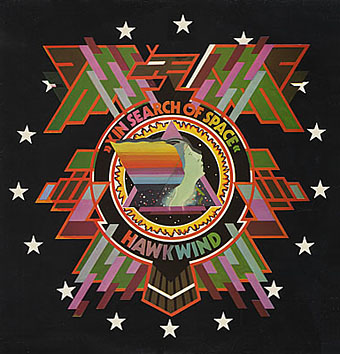
Hawkwind: In Search of Space (1971).
It’s fair to say that Hawkwind were very lucky to find Barney Bubbles, he immediately gave their music—which was often rambling and semi-improvised at the time—a compelling visual dimension that exaggerated their science fiction image while still presenting different aspects of the band’s persona. In Search of Space is an emblematic design that opens out to reveal a poster layout inside. One of the things that distinguishes Barney Bubbles’ designs from other illustrators of this period is a frequent use of hard graphical elements, something that’s here right at the outset of his work for Hawkwind.
This album also included a Bubbles-designed “Hawklog”, a booklet purporting to be the logbook of the crew of the Hawkwind spacecraft. I scanned my copy some time ago and converted it to a PDF; you can download it here.
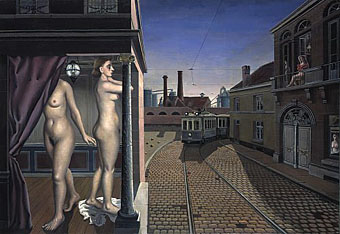
La Rue du Tramway (1938) by Paul Delvaux.
Taxandria (1994) is a feature-length fantasy film by Belgian animator Raoul Servais that’s received little attention outside his native country, possibly because it failed in the marketplace and has been deemed too weird or uncommercial to export. You only have to compare the export version of Harry Kümel’s Malpertuis with his original cut to see how inventive Belgian films are treated by US distributors.

Servais had previously made an acclaimed animated short, Harpya, using a combination of live actors and painted backgrounds. Taxandria elaborates on this process (called Servaisgraphy by its inventor) using settings designed by one of my favourite comic artists François Schuiten, creator (with Benoît Peeters) of Les Cités Obscures. Taxandria intrigues for a third reason, the inspiration of Surrealist master Paul Delvaux whose paintings served as the origin of the project. And it also contains a remarkable detail in the screenplay credit for Alain Robbe-Grillet, a man better known for making Last Year at Marienbad with Alain Resnais, and the kind of fierce intellectual one imagines would usually run a mile from this kind of extravagant whimsy.
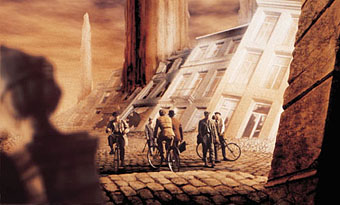
Continue reading “Taxandria, or Raoul Servais meets Paul Delvaux”
Fairy Queen (1962), ink and dyes on parchment.
A rare exhibition of work by occult artist Cameron, aka Marjorie Cameron Parsons Kimmel, can be seen at the Nicole Klagsbrun Gallery in New York.
Nicole Klagsbrun Gallery is pleased to present an exhibition of work by Cameron (1922–1995), curated by Michael Duncan, George Herms, and Nicole Klagsbrun. The exhibition runs from January 12 until February 10, 2007. An opening reception will be held on Friday, January 12, from 6–8 pm.
This survey is the first solo gallery exhibition of artist, performer, poet, and occult practitioner, Cameron (Marjorie Cameron Parsons Kimmel). A maverick follower of the esoteric mysticism of Aleister Crowley and his philosophical group, the OTO (Ordo Templi Orientis), Cameron was also an accomplished painter and draftsman and mentor to younger artists and poets such as Wallace Berman, George Herms, and David Meltzer. While enlisted in the Navy, she was assigned the tasks of drawing maps and working in a photographic unit, which led to attendance at art classes after being discharged. In Los Angeles, she became the wife and spiritual avatar of scientist and mystical thinker Jack Parsons (1914–1952), one of the founders of the Jet Propulsion Laboratory and an influential leader of the OTO.

The mundane Cameron during the Second World War.
In the early 1950s, Cameron met the fellow LA artist and jazz enthusiast Wallace Berman who was fascinated by her artwork, poetry, and mystical aura. In 1955 Berman used his photograph of Cameron as the cover of his literary and artistic journal Semina and included in the issue a drawing she had made the previous year. The drawing became renowned when the police cited it as ?lewd? and shut down Berman’s 1957 exhibition at Ferus Gallery. After this experience, Cameron, like Berman, refused to show her art in commercial galleries. She remained, however, a crucial figure in the Berman circle. Cameron’s romantic aesthetic and commanding persona prompted filmmaker Curtis Harrington to commemorate her output as a visual artist in The Wormwood Star (1955), a lyrical short film recording the art and atmosphere of her candlelit studio. Filmmaker Kenneth Anger cast her in a leading role opposite Anäis Nin in his film Inauguration of the Pleasure Dome (1954).

The occult Cameron, manifesting as the Scarlet Women for Kenneth Anger.
Despite the grim fatality of much of her writings, Cameron?s artworks portray a fanciful, even wistful lyricism. In the early 1960s she corresponded with Joseph Campbell, citing her interest in his book The Hero with a Thousand Faces, as well as in the fiction of Hermann Hesse and Isak Dinesen. Consumed by myth and the idea of protean growth, Cameron depicted the process of metamorphosis and transformation in hundreds of line drawings where ominous figures and landscapes emerge from uniformly striated, passionately articulated ink marks. Other gouache drawings and paintings depict mythic figures of her own creation engaged in ritualistic, symbolic acts.
For now, her work is barely visible on the web but there’s another small gallery of her pictures here. And just to show how MySpace is seemingly intent on resurrecting everyone who ever lived, Marjorie Cameron, Babalon 156 is in your extended network.
Nicole Klagsbrun Gallery
526 West 26th St, no. 213,
New York.
Via Jay.
Previously on { feuilleton }
• Kenneth Anger on DVD…finally
• Austin Osman Spare